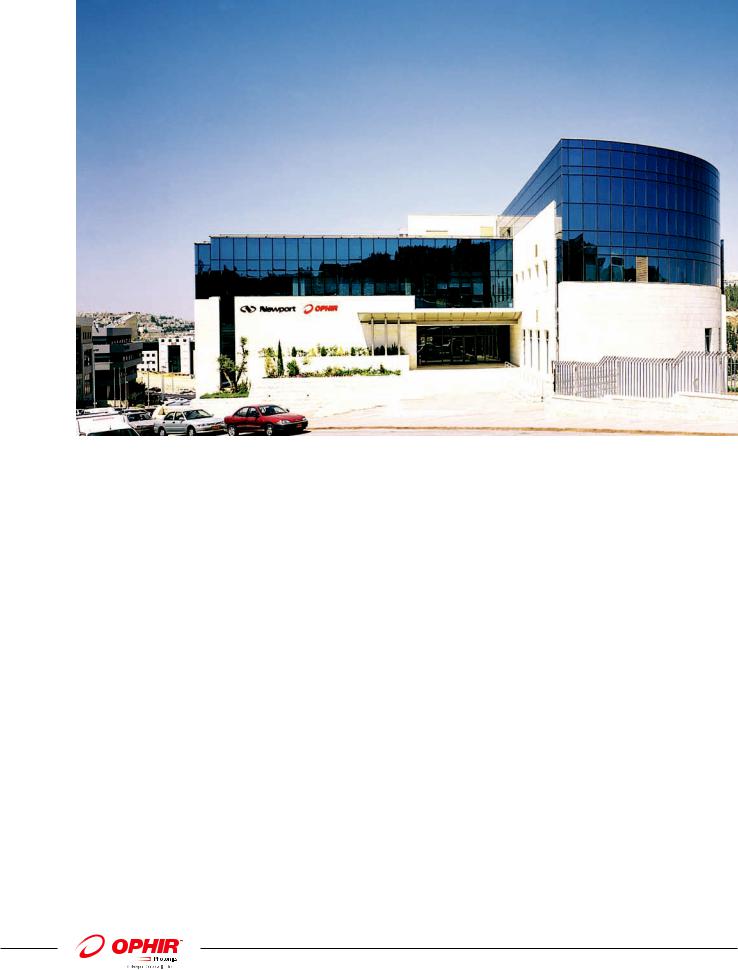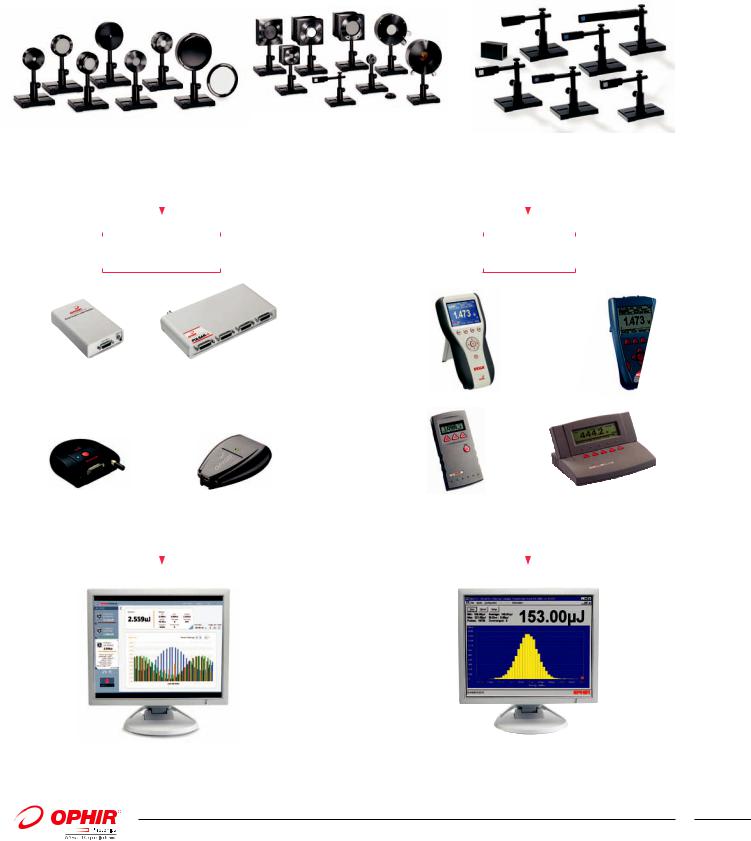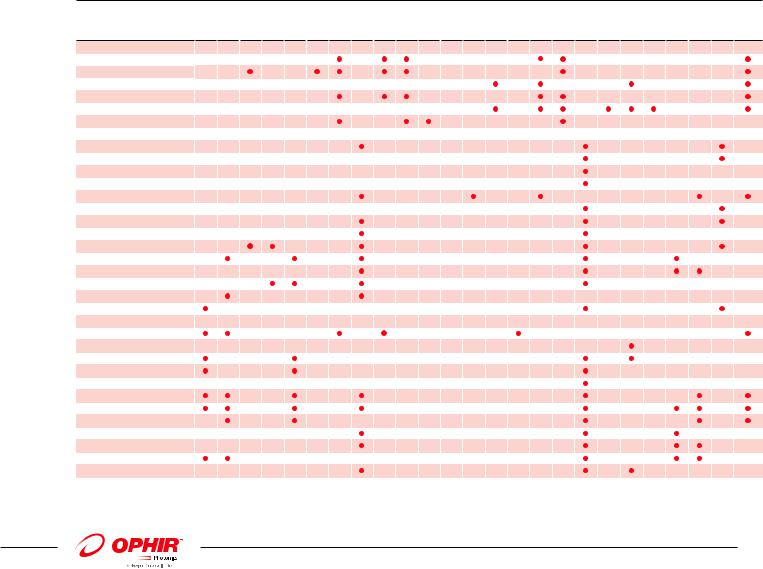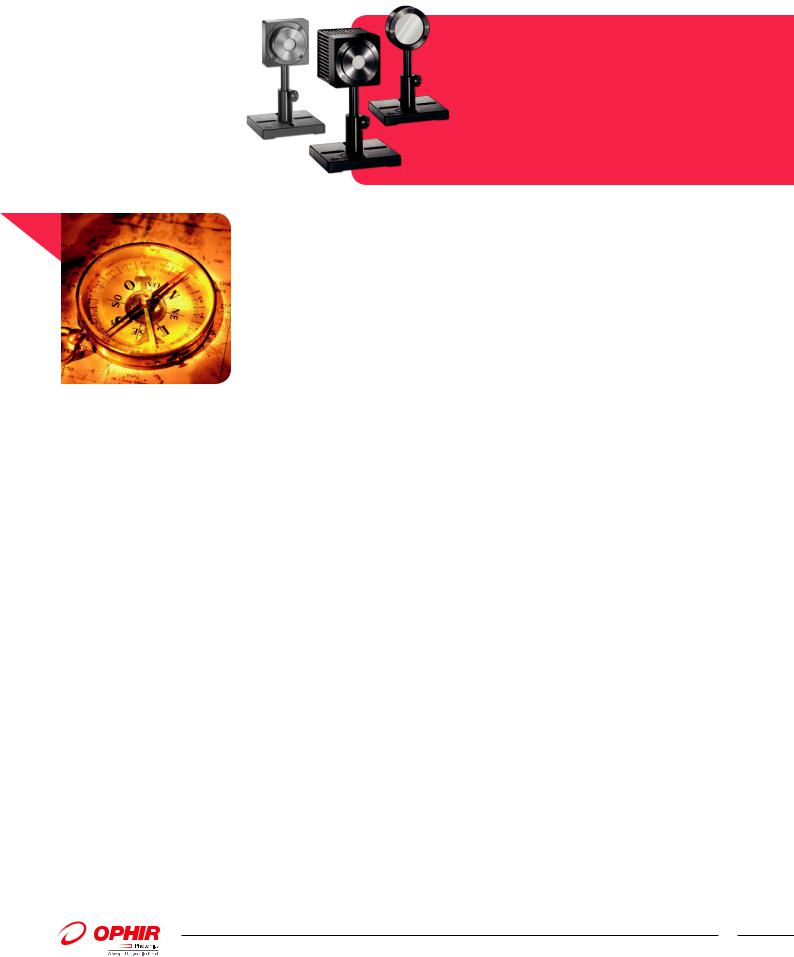
laser_measurement_instruments_catalog
.pdf
Laser Power & Energy Measurement Laser Beam Analysis
2014
Ophir®, now part of the Newport® Corporation Family of Brands
Ophir Photonics Group
For Every Laser Measurement
United to Lead the Industry
For over 35 years Ophir has met the challenge to consistently provide accurate and reliable laser power and energy measurement devices. Spiricon and Photon, during that time, have established themselves as the leader in beam profiling. Our first-class teams of scientists and engineers set the standard for innovation in the face of increasing demands for durability and precision.
The Ophir Photonics group leads the industry in all aspects of laser beam measurement.
Continual Improvement
Improvements in material science continually extend the operational limits of our increasingly damage resistant laser measurement devices. This not only ensures our undisputed position at the forefront of laser measurement technology, but also confirms our commitment to you in providing the most accurate and durable products in the market.
Constant attention to improved calibration methods further solidifies our leadership position in reliable and accurate instrumentation. As an ISO 9001:2008 company, we subject our products and systems to constant quality assurance monitoring. We are also proud to hold a number of patents for our creative products that clearly demonstrate our superior expertise in physics, electronics, optics, software and mechanics.
Total Commitment
Ophir - Spiricon - Photon products play an essential role in a variety of fields - medical, military industrial and research - where accuracy, reliability and robustness are vital prerequisites. We affirm our unswerving commitment to remain world leaders in the research and development of laser technology instrumentation, continually striving for improvement and innovation.

|
Table of contents |
Page |
|
|
|
|
|
|
|
|
|
|
|
|
|
About Ophir Optronics |
3 |
|
|
|
Ophir Power and Energy Meters - Versatitlity for Every Application |
5 |
|
|
|
Calibration Capability at Ophir |
6 |
|
|
1.0 |
Sensors |
7 |
|
|
|
Laser Power and Energy Sensors Table of Contents |
8 |
|
|
|
Sensor Finder Program |
13 |
|
|
|
General Introduction |
15 |
|
|
1.1 |
Power Sensors |
17 |
|
|
|
Power Sensors - Introduction |
18 |
|
|
|
Absorption and Damage Graphs for Thermal Sensors |
21 |
|
|
1.1.1 |
Photodiode Power Sensors |
22 |
|
|
1.1.1.1 |
Standart Photodiode Sensors 10pW to 3W |
22 |
|
|
1.1.1.2 |
Round Photodiode Sensors 20pW to 3W |
25 |
|
|
1.1.1.3 |
Special Photodiode Sensors and Integrating Spheres- 50pW-3W and 20mLux200kLux |
26 |
|
|
1.1.2 |
Thermal Power Sensors |
28 |
|
|
1.1.2.1 |
High Sensitivity Thermal Sensors 8µW-12W |
28 |
|
|
1.1.2.2 |
Low Power Thermal Sensors 20mW150W |
30 |
|
|
1.1.2.3 |
Low-Medium Power Thermal SensorsApertures to 35mm, 10mW150W |
32 |
|
|
1.1.2.4 |
Medium Power Large Aperture Thermal SensorsApertures 50mm-65mm, 100mW300W |
35 |
|
|
1.1.2.5 |
MediumHigh Power Fan Cooled Thermal Sensors 50mW500W |
37 |
|
|
1.1.2.6 |
High Power Thermal Sensors |
39 |
|
|
1.1.2.6.1 |
High Power Thermal Sensors - Introduction |
39 |
|
|
1.1.2.6.2 |
High Power Water Cooled Thermal Sensors 1W-100kW |
40 |
|
|
1.1.2.6.3 |
Protective Housing for 5000W and 10K-W Sensors |
43 |
|
|
1.1.2.6.4 |
Very High Power Water Cooled Thermal Sensors 100W-100kW |
44 |
|
|
1.1.2.6.5 |
Power Pucks 20W-10kW |
46 |
|
|
1.1.2.6.6 |
Beam Dumps Up to 10kW |
47 |
|
|
1.1.3 |
BeamTrack Power/Position/Size Sensors |
48 |
|
|
1.1.3.1 |
BeamTrack Introduction |
48 |
|
|
1.1.3.2 |
Low Power BeamTrack Power/Position/Size Sensors 100µW-10W |
49 |
|
|
1.1.3.3 |
Medium Power BeamTrack Power/Position/Size Sensors 40mW-150W |
50 |
|
|
1.1.3.4 |
Medium-High Power BeamTrack Power/Position/Size Sensors 150mW-1000W |
51 |
|
|
1.1.3.5 |
BeamTrack - Device Software Support |
52 |
|
|
1.1.3.6 |
BeamTrack - PC Software Support |
53 |
|
|
1.1.4 |
Power Sensors Accessories |
54 |
|
|
1.1.4.1 |
Accessories for PD300 Sensors |
54 |
|
|
1.1.4.2 |
Accessories for Thermal Sensors, PD300R, PD300-IRG, 3A-IS, FPS-1 |
55 |
|
|
1.2 |
Energy Sensors |
56 |
|
|
|
Energy SensorsIntroduction |
57 |
|
|
|
Absorption and Damage Graphs for Pyroelectric Sensors |
58 |
|
|
|
Wavelength Range and Repetition Rate for Energy Sensors |
59 |
|
|
1.2.1 |
Photodiode Energy Sensors 10pJ15µJ |
60 |
|
|
1.2.2 |
Pyroelectric Energy Sensors 0.05µJ-10J |
61 |
|
|
1.2.3 |
High Energy Pyroelectric Sensors 10µJ-40J |
65 |
|
|
1.2.4 |
Energy Sensors Accessories |
69 |
|
|
1.2.4.1 |
Accessories for Pyroelectric Sensor |
69 |
|
|
1.2.4.2 |
Fast Photodetector Model FPS-1 |
71 |
|
|
1.3 |
OEM Solutions |
72 |
|
|
1.3.1 |
OEM Solutions - Introducation |
72 |
|
|
1.3.2 |
Thermal and Photodiode OEM Sensors |
73 |
|
|
1.3.2.1 |
OEM Sensor Usage |
73 |
|
|
1.3.2.2 |
Advantages of Ophir Thermal and Photodiode OEM Sensors |
74 |
|
|
1.3.2.3 |
Standard OEM Thermal and Photodiode Sensors 100pW-300W |
75 |
|
|
1.3.2.4 |
Examples of Customer OEM Thermal and Photodiode Sensor Solutions |
80 |
|
|
1.3.3 |
Pyroelectric OEM Sensors |
81 |
|
|
1.3.3.1 |
Pyroelectric OEM Sensors - Introduction |
81 |
|
|
1.3.3.2 |
Standard Pyroelectric OEM Sensors <0.1µJ - 40J |
82 |
|
|
2.0 |
Power Meters |
83 |
|
|
|
Power Meter Finder |
84 |
|
|
|
Power Meters and PC Interfaces |
86 |
|
|
2.1 |
Power Meters |
87 |
|
|
2.1.1 |
Vega |
87 |
|
|
2.1.2 |
Nova II |
89 |
|
|
2.1.3 |
LaserStar |
91 |
|
|
2.1.4 |
Nova |
93 |
|
|
2.1.5 |
StarLite |
95 |
|
|
2.1.6 |
Accessories |
97 |
|
|
3.0 Beam Analysis 2.0 Power Meters 1.0 Sensors
1
For latest updates please visit our website: www.ophiropt.com/photonics |
|
|
|
01.04.2014 |

3.0 Beam Analysis 2.0 Power Meters 1.0 Sensors
2
2.2 |
PC Interfaces |
98 |
|
|
2.2.1 |
PC Connectivity Options for Power/Energy Measurement |
98 |
|
|
2.2.2 |
Compact Juno USB Interface |
99 |
|
|
2.2.3 |
Pulsar Multichannel and Triggered USB Interfaces |
100 |
|
|
2.2.4 |
Quasar Wireless Bluetooth Interface |
101 |
|
|
2.2.5 |
Summary of Computer Options for Ophir Meters and Interfaces |
102 |
|
|
2.3 |
Software Solutions |
103 |
|
|
2.3.1 |
StarLab |
103 |
|
|
2.3.2 |
StarCom |
105 |
|
|
2.3.3 |
LabVIEW Solutions |
107 |
|
|
3.0Laser Beam Analysis
3.1 |
Choosing a Beam Profiler |
110 |
|
|
3.1.1 |
Four Basic Questions |
110 |
|
|
3.1.2 |
One More Question |
111 |
|
|
3.1.3 |
User Guide for Choosing the Optimum Beam Profiling System |
112 |
|
|
3.1.4 |
Benefits of Beam Profiling |
114 |
|
|
3.2 |
Introduction to Camera-Based Profilers |
115 |
|
|
3.2.1 |
BeamGage |
116 |
|
|
3.2.1.1 |
BeamGage-Standart Version |
116 |
|
|
3.2.1.2 |
BeamGage-Professional |
124 |
|
|
3.2.1.3 |
BeamGage-Enterprise |
125 |
|
|
3.2.1.4 |
Software Comparision Chart |
126 |
|
|
3.2.2 |
BeamMic - Basic Laser Beam Analyzer System |
134 |
|
|
3.2.3 |
BeamWatch |
139 |
|
|
3.2.4 |
Cameras |
142 |
|
|
3.2.4.1 |
190-1100nm USB Silicon CCD Cameras |
142 |
|
|
3.2.4.2 |
190-1100nm Firewire Silicon CCD Cameras |
144 |
|
|
3.2.4.3 |
190-1100nm Gig-E Silicon CCD Cameras |
145 |
|
|
3.2.4.4 |
1440-1605nm Phosphor Coated CCD Cameras For NIR Response |
146 |
|
|
3.2.4.5 |
900-1700nm - InGaAs NIR Cameras |
149 |
|
|
3.2.5 |
13-355nm & 1.06-3000µm - Pyrolectric Array Camera |
150 |
|
|
3.2.5.1 |
YAG Focal Spot Analyzer |
157 |
|
|
3.3 |
Introduction to Scanning-Slit Profilers |
159 |
|
|
3.3.1 |
NanoScan 2 |
160 |
|
|
3.3.2 |
NanoScan 1 for Large Beams |
174 |
|
|
3.4 |
Accessories for Beam Profiling |
183 |
|
|
3.4.1 |
Neutral Density Attenuators/Filters |
183 |
|
|
3.4.2 |
Beam Splitter + Neutral Density Filters Combo |
187 |
|
|
3.4.3 |
Beam Splitter |
190 |
|
|
3.4.4 |
Beam Expanders Microscope Objectives |
193 |
|
|
3.4.5 |
Beam Reducers |
195 |
|
|
3.4.6 |
CCTV lens for front imaging through glass or reflected surface |
196 |
|
|
3.4.7 |
Imaging UV lasers |
197 |
|
|
3.5 |
Near Field Profilers |
199 |
|
|
3.5.1 |
Camera Based Near-Field Profiler |
199 |
|
|
3.5.2 |
Split-Based NanoScan Near-Field Profiler |
200 |
|
|
3.6 |
What is M²? |
202 |
|
|
3.6.1 |
Camera Based Beam Propagation Analyzer: M² |
203 |
|
|
3.6.1.1 |
Specifications for the M²-200s |
205 |
|
|
3.6.1.2 |
Model 1780 |
206 |
|
|
3.6.2 |
Slit-Based Beam Propagation Analyzer M² |
208 |
|
|
3.7 |
Integraed Laser Performance Measurements |
211 |
|
|
3.7.1 |
Beam Cube |
211 |
|
|
3.8 |
High-Power Applications |
215 |
|
|
3.8.1 |
High-Power NanoScan |
215 |
|
|
3.8.2 |
High Power - Laser Profiler Kits for CO |
217 |
|
|
3.8.3 |
High Power - ModeCheck- A New Method to Assure the Performance of High Power CO Lasers |
218 |
|
|
3.9 |
Goniometric Radiometers |
220 |
|
|
|
Product Index |
223 |
|
|
|
Part Number Index |
231 |
|
|
|
Distributors list |
233 |
|
|
01.04.2014 |
|
For latest updates please visit our website: www.ophiropt.com/photonics |
|

About Ophir Optronics
Ophir Optronics, a Newport corporation brand was founded in 1976, as an optical coating company that has grown and diversified into other areas. Ophir employs a highly-qualified staff of over 570 engineers, technicians and skilled workers. Our company products are sold worldwide through a distribution network that includes four fully certified calibration facilities and repair centers. The majority of Ophir’s laser measuring instrumentation line is exported and marketed by sales
representatives in more than 35 countries around the world, the largest markets being the USA, Europe and Japan.
About Newport
Newport® was established 45 years ago to create and manufacture solutions to support a newly formed laser industry and quickly became the leader in vibration control, motion control and photonic tools. Our passion is photonics, our vision is to continually advance the industry by integrating leading expertise and photonics tools to create the solutions that will enable research and manufacturing to advance and create new possibilities in the markets we serve. To empower this advancement Newport has become home to a comprehensive family of leading brands including: New Focus™ with 20 years of leadership in developing, manufacturing and delivering
innovative, high-performance, quality, and easy-to-use photonics. Oriel® Instruments, for 40 years, has been a pioneer in solutions for making and measuring light. Richardson Gratings™, for over 60 years, has been the gratings leader; delivering custom gratings and the largest breadth of off-the-shelf gratings. Spectra-Physics®, established 50 years ago, was a catalyst to a new industry as the first commercial laser company and today continues to lead laser innovation. And our newest addition, Ophir® founded in 1976, is a global leader in precision IR optics, laser measurement instrumentation and 3D non-contact measurement equipment.
Our Facilities
Sited in an impressive 10,400 sq.m. (112,500 sq.ft.) building in Jerusalem, Israel, Ophir’s main manufacturing and R&D facility is fully equipped for both the production and testing of laser measuring instrumentation, optical components and coatings. In addition, Ophir’s modern facilities have in-house capability for diamond turning, aspheric optics and electronic equipment
assembly. Our laser beam profiling activities are now centered at the Spiricon facility in Logan Utah and Photon.Inc facility in San Jose California, USA with complete design, manufacturing, testing and service facilities.
Ophir’s wide-ranging activities include:
ֺProduction of the most complete variety of laser measurement instrumentation in existence, both off-the shelf and OEM. Production of very high precision infrared and visible optical components: lenses, mirrors, metallic optics (spherical, aspherical and diffractive), windows, domes and prisms,
suitable for military (FLIR) and industrial (CO2) applications. Ophir, a qualified manufacturer for some of the world's leading suppliers of night vision equipment, is renowned for having developed some of the highest performing and most costeffective optical systems in the world.
ֺDesign and production of optical assemblies. Thin film optical coatings.
ֺNon-contact optical equipment for distance measurement and three-dimensional mapping of objects developed by Optimet, a company in which Ophir has a majority share. These devices are based on patented technology called Conoscopic Holography. Application include dentistry microelectronics, robotics, quality control and mechanical shops.
Laser Development
The history of laser development has been characterized by ever-increasing laser powers and energies and increasingly concentrated laser beams. Medical, industrial and scientific applications of these high power and energy density lasers require reliable and accurate measurement of power and energy.
Meters for relatively high powers and energies generally operate by measuring the heat deposited onto an absorbing element. The key to accurate and reliable measurement is the makeup of this absorbing surface. It must stand up to repeated use without degradation or change in calibration.
Laser sources are constantly growing in power, energy and beam concentration. Ophir has an ongoing program of development of durable absorbing surfaces that will continue to stand up to the most punishing laser sources as they grow in intensity and Ophir has some of the highest damage threshold absorbers in the industry.
Ophir - Spiricon - Photon brings the same leading edge innovation to laser beam profile measurement with its famous Pyrocam, its
in house designed SP and Nanoscan cameras and BeamGage software.
Ophir’s Laser Measurement Group products are used in three highly competitive and sophisticated fields: medical, industrial and research. Each of these areas is further divided into end users and OEMs.
Medical
Ophir is the largest producer of laser power and energy measurement equipment for the medical market, where Ophir's power measurement devices are incorporated into laser-
based instrumentation. Our products are vital to medical laser manufacturers and to the hospitals and doctors who are end-user laser purchasers.
Medical lasers cover the entire spectrum of wavelengths from the 193 nm excimer laser to the 10.6 micron CO2 laser where the main laser wavelengths are 193, 248, 532, 694, 755, 808, 1064, 2100, 2940 and 10600 nm. These lasers are used for general surgery, eye surgery, gynecology, ORL, dermatology and other applications.
3
For latest updates please visit our website: www.ophiropt.com/photonics |
01.04.2014 |

They have outputs which start at mW and mJ on the low end going up to tens of joules and hundreds of watts at the high end. The trend in medical lasers is to progress to more powerful systems, especially in the dermatology field, and to introduce diode lasers and intense pulsed light (IPL) sources instead of the traditional gas or solid state lasers.
Ophir has developed special equipment that can for the first time measure the output of IPL sources.
Regulating bodies such as the FDA in the USA require the manufacturers to have at least one channel of power or energy monitoring in each laser. Ophir’s high-quality OEM products provide an extraordinarily efficient answer to this requirement.
Industrial
Industrial laser customers include both laser manufacturers and laser users in job shops and factories. Ophir answers the needs of this market by providing measurement systems that have a high damage threshold and the ability to measure high repetition rates with high accuracy.
There are two main types of laser for industrial and material processing applications: the CO2 laser at 10.6 microns and the Nd YAG laser at 1.064 micron. These lasers are used for cutting, welding, trimming, marking and other functions on many types of material such as metal, wood, plastic, etc. They are characterized by their high power output, which ranges from
4
100W to 30kW, depending on the application. With its capabilities in power, energy and profile measurement, Ophir has developed many products for this market including an integrated Laser Beam Analyzer for industrial YAG lasers which measures beam profile, temporal profile, power and energy, all in one unit. A subset of the industrial market is the microelectronics industry, which uses excimer lasers for exposing the photoresist in the photolithography process. This process uses lasers with a short wavelength of 193 to 345 nm that operate at high repetition rate and high energy. The main factor influencing the component density possible on the microchip is the wavelength of the laser already used in the process, and therefore the trend is to progress to shorter wavelengths. Ophir has a range of unique products specified for the photolithography market, including off-the-shelf and OEM products.
RoHS
Almost all Ophir and Spiricon Laser measurement products are now RoHS compliant. The few products that are not RoHS are specified as such in the ordering information.
01.04.2014 |
|
For latest updates please visit our website: www.ophiropt.com/photonics |
|

Ophir Power and Energy Meters – Versatility for Every Application
Ophir sensor, power meter and computer interface system means that virtually any sensor can work “plug and play” with any power meter or computer interface. Ophir has the widest range of sensors on the market with the highest performance so almost any measurement need can be accommodated. The measurement results can also be used in many ways - on the power meter screen, stored on board, sent to PC with results presented in many ways and on several platforms.
Pyroelectric Sensors |
Thermal Sensors |
Photodiode Sensors |
||||||
Energies pJ to Joules |
Powers mW to kW and |
Powers pW to Watts |
||||||
Rep rates to 25kHz |
single shot energy |
|
|
|
||||
|
|
|
|
|
|
|
|
|
|
|
|
|
|
|
|
|
|
|
|
|
|
|
|
|
|
|
|
|
|
|
|
|
|
|
|
|
|
|
|
|
|
|
|
|
|
|
|
|
|
|
|
|
|
Computer Interfaces with USB / Bluetooth
Power Meters with USB/RS232
USB Interface |
Pulsar |
Vega |
Nova ll |
basic |
channels 4 ,2 ,1 |
color |
general |
Quasar |
Juno |
Nova |
Laser Star |
wireless |
compact |
compact |
2 channel |
|
|
|
|
|
|
|
|
|
|
|
|
Software Solutions
StarLab, LabVIEW, StarCom
COM Object
5
For latest updates please visit our website: www.ophiropt.com/photonics |
01.04.2014 |

Calibration Capability at Ophir
Calibration is perhaps the most important of our products. In order to insure the best possible calibration of your laser measuring instrumentation, Ophir takes a number of extra steps not taken by other vendors.
As can be seen by the absorption graphs in the sensor section, laser absorbers vary with wavelength, so it is not enough to calibrate at 1 wavelength. If the variation in absorption with wavelength is small, then the sensors are calibrated at several laser wavelengths and each laser covers a range of wavelengths. If the absorption variation with wavelength is considerable, the sensor software is provided with an absorption correction curve that is activated by selecting the wavelength of use. In addition to the above, only Ophir goes one step further and checks the curve at a number of NIST and PTB traceable wavelengths and corrects it if necessary. To do this, we have a
complete line of calibration lasers so that we can always calibrate at or near the customer’s wavelength. These lasers include powers up to 400W and both CW and pulsed lasers. In addition, we have a number of sensors calibrated at NIST and PTB used as calibration standards. Below is a list of the calibration wavelengths used at Ophir in calibrating our standard catalog sensors.
In addition to calibration variation with wavelength, there are other possible sources of calibration error such as nonlinearity variation with position on the surface and for pyroelectric sensors, pulse frequency. All of these factors are carefully taken into consideration in calibration and accounted for. For a complete discussion and analysis of Ophir calibration accuracy and error budget, please see our website at: www.ophiropt.com/calibration-procedure/tutorial
Special Calibration
In addition to standard calibration wavelengths shown below customers can have their Ophir sensor calibrated at additional wavelengths for more accuracy. Please consult your Ophir agent for special requests.
Wavelengths of Calibration per Sensor Type
Pulsed/Continuous |
193 |
248 |
254 |
266 |
355 |
365 |
436 |
532 |
577 |
633 |
675 |
755 |
808 |
820 |
905 |
980 |
1014 |
1064 |
1310 |
1550 |
1600 |
2100 |
2940 |
10600 |
Spectral |
|
P |
P |
C |
P |
P |
C |
C |
P,C |
C |
C |
C |
P |
C |
C |
P |
C |
C |
P,C |
C |
P,C |
C |
P |
P |
C |
curve |
|
|
Photodiode sensors
PD300 PD300-UV PD300-IR PD300-3W PD300-IRG 3A-IS
Thermal sensors
Standard Broadband<1500W Standard Broadband>=1500W 30K-W
100K-W
LP1 type Comet 10K Comet 1K
P type
PF type PF with diffuser
HE type HE with diffuser
EX type
SV type
Pyroelectric sensors
PD10-C, PD10-pJ-C PD10-IR-pJ-C
PE9-C PE10-C
BB type
BF type BF with diffuser
Metallic (standard) PE50BB-DIF-C PE50-DIF-ER-C PE50-DIF-C PE100BF-DIF-C
6
01.04.2014 |
|
For latest updates please visit our website: www.ophiropt.com/photonics |
|

Sensors
7
For latest updates please visit our website: www.ophiropt.com/photonics |
01.04.2014 |

1.0 Sensors
Sensors Table of Contents
Power sensors
Photodiode Power Sensors
Standard photodiode sensors - 10pW - 3W
Sensor |
|
Features |
|
Aperture |
|
Spectral Range |
|
Power Range |
|
Page |
PD300 |
|
Automatic background subtraction |
|
10x10mm |
|
350-1100nm |
|
500pW-300mW |
|
22 |
PD300-1W |
|
Automatic background subtraction |
|
10x10mm |
|
350-1100nm |
|
500pW-1W |
|
22 |
PD300-3W |
|
High power |
|
10x10mm |
|
350-1100nm |
|
5nW-3W |
|
22 |
PD300-TP |
|
Very thin profile (4mm only) |
|
10x10mm |
|
350-1100nm |
|
50pW-1W |
|
22 |
PD300-UV |
|
Wide spectral range and low noise |
|
10x10mm |
|
200-1100nm |
|
20pW-300mW |
|
23 |
PD300-IR |
|
Infrared |
|
Ø5mm |
|
700-1800nm |
|
5nW-300mW |
|
23 |
PD300-IRG |
|
Very low noise 300 femto watts |
|
Ø5mm (max) |
|
800-1700nm |
|
10pW-150mW |
|
23 |
Round photodiode sensors - 20pW - 3W
Sensor |
|
Features |
|
Aperture |
|
Spectral Range |
|
Power Range |
|
Page |
PD300R |
|
Same as PD300, circular for easy centering |
|
Ø10mm |
|
350-1100nm |
|
500pW-300mW |
|
25 |
PD300R-3W |
|
Same as PD300-3W, circular geometry |
|
Ø10mm |
|
350-1100nm |
|
5nW-3W |
|
25 |
PD300R-UV |
|
Same as PD300-UV, circular geometry |
|
Ø10mm |
|
200-1100nm |
|
20pW-300mW |
|
25 |
PD300R-IR |
|
Same as PD300-IR, circular geometry |
|
Ø5mm |
|
700-1800nm |
|
5nW-300mW |
|
25 |
Special photodiode sensors and integrating spheres - 50pW - 3W and 20mLux - 200kLux
Sensor |
|
Features |
|
Aperture |
|
Spectral Range |
|
Power Range |
|
Page |
Special photodiode sensors |
|
|
|
|
|
|
|
|
||
PD300-BB |
|
Flat spectral response from 430 to 1000nm |
|
10x10mm |
|
430-1000nm |
|
50pW-4mW |
26 |
|
PD300-BB-50mW |
|
For broadband light sources to 50mW |
|
10x10mm |
|
430-1000nm |
|
50pW-50mW |
|
26 |
PD300-CIE |
|
Measurement in units of Lux or foot candles |
|
2.4x2.8mm |
|
400-700nm |
|
20mLux-200kLux |
|
26 |
BC20 |
|
Meter for scanned beams at up to 30,000 inch/s |
|
10x10mm |
|
633, 650, 675nm |
|
100μW-20mW |
|
26 |
Special sensors - integrating spheres |
|
|
|
|
|
|
|
|
||
3A-IS |
|
Integrating sphere for divergent beams to 3W |
|
Ø12mm |
|
420-1100nm |
|
1μW-3W |
27 |
|
3A-IS-IRG |
|
Integrating sphere for divergent beams to 3W for near IR |
|
Ø12mm |
|
800-1700nm |
|
1μW-3W |
27 |
|
Thermal Power Sensors
High sensitivity thermal sensors - 8µW - 12W
Sensor |
|
Features |
|
Aperture |
|
Spectral Range |
|
Power Range |
|
Energy Range |
|
Page |
3A |
|
Very low powers |
|
Ø9.5mm |
|
0.19-20μm |
|
10μW-3W |
|
20μJ-2J |
|
28 |
3A-P |
|
Low powers and energies |
|
Ø12mm |
|
0.15-8μm |
|
15μW-3W |
|
20μJ-2J |
|
28 |
3A-P-THz |
|
3A-P sensor calibrated for Terahertz wavelengths |
|
Ø12mm |
|
0.3-10THz |
|
15μW-3W |
|
20μJ-2J |
|
28 |
3A-FS |
|
Lowest powers, Fused Silica window |
|
Ø9.5mm |
|
0.19-20μm |
|
8μW-3W |
|
15μJ-2J |
|
28 |
3A-P-FS-12 |
|
For divergent beams, window blocks infrared |
|
Ø12mm |
|
0.22 - 2.1μm |
|
15µW - 3W |
|
20µJ-2J |
|
28 |
12A |
|
Wide dynamic range to 12W |
|
Ø16mm |
|
0.19-20μm |
|
2mW-12W |
|
1mJ-30J |
|
29 |
12A-P |
|
Short pulse lasers to 12W |
|
Ø16mm |
|
0.15-8μm |
|
2mW-12W |
|
1mJ-30J |
|
29 |
Low power thermal sensors - 20mW - 150W
Sensor |
|
Features |
|
Aperture |
|
Spectral Range |
|
Power Range |
|
Energy Range |
|
Page |
10A |
|
General purpose to 10W |
|
Ø16mm |
|
0.19-20μm |
|
20mW-10W |
|
6mJ-2J |
|
30 |
30A-BB-18 |
|
General purpose to 30W |
|
Ø17.5mm |
|
0.19-20μm |
|
20mW-30W |
|
6mJ-30J |
|
30 |
L30A-10MM |
|
Thin Profile to 30W |
|
Ø26mm |
|
0.15-20μm |
|
80mW-30W |
|
20mJ-60J |
|
30 |
50(150)A-BB-26 |
|
General purpose to 50W, 150W intermittent |
|
Ø26mm |
|
0.19-20μm |
|
40mW-150W |
|
20mJ-100J |
|
30 |
10A-P |
|
Pulsed lasers up to 10W |
|
Ø16mm |
|
0.15-8μm |
|
40mW-10W |
|
10mJ-10J |
|
31 |
30A-P-17 |
|
Short pulse lasers to 30W |
|
Ø17mm |
|
0.15-8μm |
|
60mW-30W |
|
40mJ-30J |
|
31 |
50A-PF-DIF-18 |
|
High energy density pulsed beams |
|
Ø17.5mm |
|
0.24 - 2.2μm |
|
140mW-50W |
|
60mJ-200J |
|
31 |
15(50)A-PF-DIF-18 |
|
As above, compact for intermittent use |
|
Ø17.5mm |
|
0.24 - 2.2μm |
|
140mW-50W |
|
60mJ-200J |
|
31 |
30A-N-18 |
|
High power density pulsed YAG |
|
Ø17.5mm |
|
0.532, 1.064μm |
|
60mW-30W |
|
30mJ-200J |
|
31 |
Low-medium power thermal sensors - apertures 12mm to 35mm, 10mW - 150W
Sensor |
|
Features |
|
Aperture |
|
Spectral Range |
|
Power Range |
|
Energy Range |
|
Page |
30(150)A-BB-18 |
|
CW to 30W, intermittent to 150W |
|
Ø17.5mm |
|
0.19-20μm |
|
30mW-150W |
|
20mJ-100J |
|
32 |
30(150)A-LP1-18 |
|
As above, high damage threshold for long pulses and CW |
|
Ø17.5mm |
|
0.25-2.2μm |
|
30mW-150W |
|
20mJ-300J |
|
32 |
L50(150)A-BB-35 |
|
CW to 50W, intermittent to 150W |
|
Ø35mm |
|
0.19-20μm |
|
100mW-150W |
|
40mJ-300J |
|
32 |
8
01.04.2014 |
|
For latest updates please visit our website: www.ophiropt.com/photonics |
|
